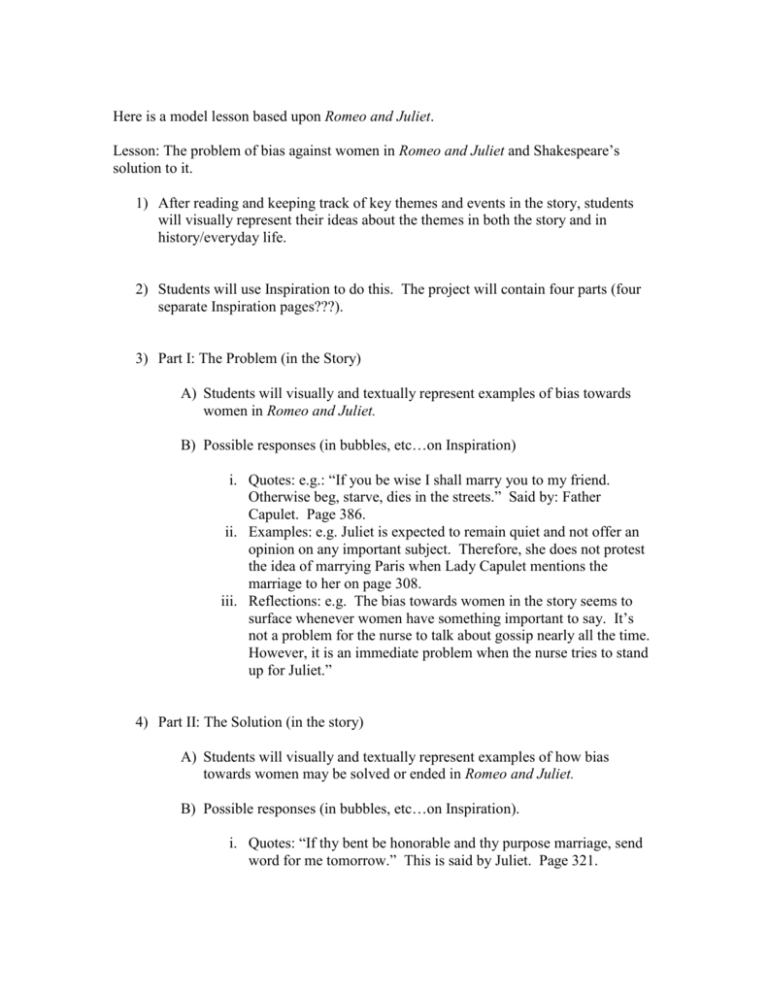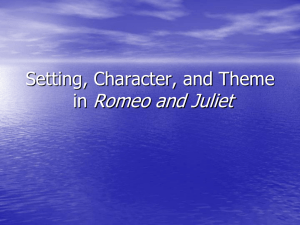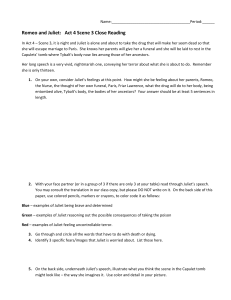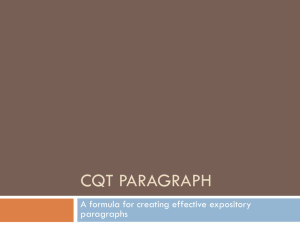Lesson: The problem of bias against women in Romeo and Juliet
advertisement

Here is a model lesson based upon Romeo and Juliet. Lesson: The problem of bias against women in Romeo and Juliet and Shakespeare’s solution to it. 1) After reading and keeping track of key themes and events in the story, students will visually represent their ideas about the themes in both the story and in history/everyday life. 2) Students will use Inspiration to do this. The project will contain four parts (four separate Inspiration pages???). 3) Part I: The Problem (in the Story) A) Students will visually and textually represent examples of bias towards women in Romeo and Juliet. B) Possible responses (in bubbles, etc…on Inspiration) i. Quotes: e.g.: “If you be wise I shall marry you to my friend. Otherwise beg, starve, dies in the streets.” Said by: Father Capulet. Page 386. ii. Examples: e.g. Juliet is expected to remain quiet and not offer an opinion on any important subject. Therefore, she does not protest the idea of marrying Paris when Lady Capulet mentions the marriage to her on page 308. iii. Reflections: e.g. The bias towards women in the story seems to surface whenever women have something important to say. It’s not a problem for the nurse to talk about gossip nearly all the time. However, it is an immediate problem when the nurse tries to stand up for Juliet.” 4) Part II: The Solution (in the story) A) Students will visually and textually represent examples of how bias towards women may be solved or ended in Romeo and Juliet. B) Possible responses (in bubbles, etc…on Inspiration). i. Quotes: “If thy bent be honorable and thy purpose marriage, send word for me tomorrow.” This is said by Juliet. Page 321. ii. Examples: Juliet attempts to solve the problem of bias towards women in the story by independently taking matters into her own hands. Instead of explaining her feelings and desires to her family, which would not have been listened to because she was a woman, she forms her own plan of action. On page 400 Juliet decides to take a potion that will make her appear dead. This will eventually allow her to run away with Romeo. iii. Reflections: One way characters try to solve the problem of bias in the story is by ending their own lives. No one seems to listen to the problems of Juliet or any of the women. Juliet, faced with no way of achieving her goals, at least ends the bias towards her self by ending her life. Ironically, by killing herself Juliet is simply dead. She does not make herself happy, nor really end any bias at all. 5) Part III: The Problem (in history/everyday life) A) Students will use pictures and text to illustrate bias towards women in history/everyday life. B) Possible pictures: sad face, “quiet please” sign, person’s face making the “shush” sign with their finger at their mouth, a picture of a woman and a child…both looking poor or unhappy, etc… C) Possible text (written with pictures) i. Reflections on history: Until the 20th Century, women were expected to remain quiet and not offer any opinions on important events. This led to many brilliant women forced to live in silence. ii. Historical facts: Women would legally not have custody of their children when married as late as the 1800’s. Once married, the husband was considered the sole legal guardian of the children. iii. Personal Observations: When I walked to my girls’ lacrosse game today I passed a group of guys. One of them said, “I don’t care about the girls’ games. All women’s sports are more boring then men’s sports. Girls just aren’t as talented as guys in athletics. 6) Part IV: The Solution (in history/everyday life) A) Students will use pictures and text to illustrate possible solutions towards bias against women in history/everyday life. B) Possible pictures: Important Historical Women (Elizabeth Cady Stanton, Queen Elizabeth, Joan of Arc, Rosa Parks, etc…), photos of women playing sports, photos of women in business or educational situations, photos of women making speeches, hearts, family pictures, etc… C) Possible text (written with pictures) i. Reflections on history: Many women, such as Elizabeth Cady Stanton, have spoken out against bias towards women at great risk to their own lives. Because of people like Stanton, however, women have made many advances over the years. ii. Historical Facts: More women attend and graduate from universities today than men. iii. Personal Observations: People at my mother’s first job used to tease her. The men she worked with often told her that she couldn’t make intellectual decisions in tough situations because women couldn’t handle pressure as well as men. Today, my mother works at a job for which she is the boss of many people, including men. iv. Personal Opinion: In my opinion, if the bias towards women is ever to end, women need to speak their minds freely. They can’t sit back politely and allow others to make their decisions. They must take matters into their own hands.







